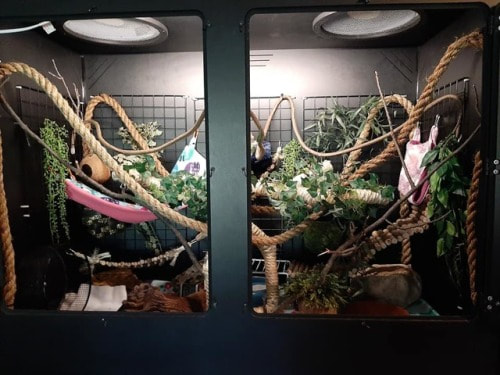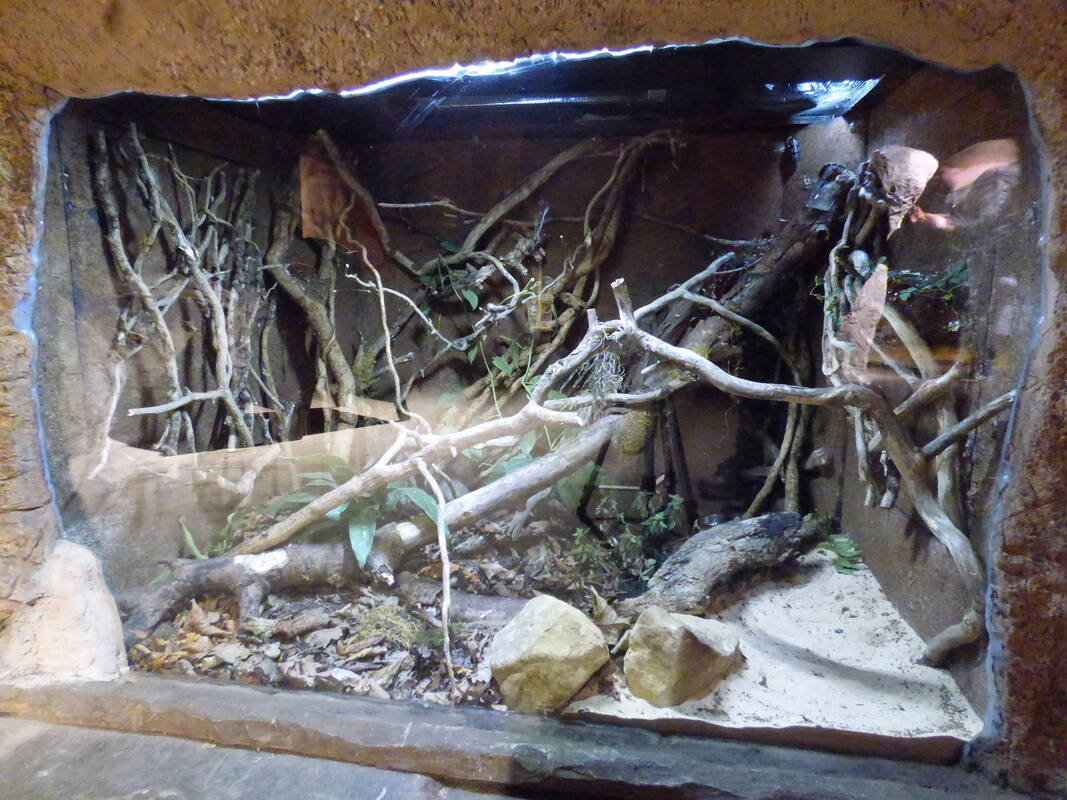General Information:
Originally from Madagascar, the domestic lesser hedgehog tenrec is a phenomenal example of convergent evolution. Believe it or not, hedgehogs and tenrecs aren't even remotely related to each other, despite their similarities. Convergent evolution describes two species that have similar structures or features, usually with the same function, but are not closely related. Hedgehogs and Tenrecs have both evolved to have spines/quills on their body that can be used as a defence mechanism. There are slight differences in their spines, but their function is the same.
Lesser Madagascan tenrecs are members of the order Afrosricida, the suborder Tenrecomorpha, and in the family Tenrecidaie. They're also the only species in the genus Echinops.
Despite their similar appearance, care for the lesser Madagascan tenrec isn't the same as African Pygmy Hedgehogs (the common domestic hedgehog).
They're an omnivorous mammal that is mostly insectivorous. They're primarily nocturnal, with an average lifespan of 7-10 years - some have even been reported to live 14 years.
It is important to note when researching about lesser hedgehog tenrecs that there is limited understanding about their care when compared to that of other exotic pets, so please be cautious about where you're sourcing your information from.
Fun Fact:
Lesser Hedgehog Tenrecs do not have external genitalia and instead poses a cloaca, meaning you're unable to determine the sex as you would with most mammals. A good way to determine your tenrecs sex is by their head shape or by expressing the phallus.
Care:
Housing/Enrichment:
Tenrecs are best housed in large 6ft/2-3ft vivariums. They require an external heat source; ideally, from a 100-150W CHE (ceramic heat emitter) with a suitable guard, you'll need to ensure the temperature is kept at 22°C which can be done with a heat lamp and pulse thermostat - ideally monitor inside the enclosure with thermometers as well. Without an adequate heat source, they may enter brumation. As they're naturally found in dry climates, try to avoid excessive humidity levels.
Tenrecs enjoy burrowing, so we would advise against using fleece. Rather, we'd use a generous layer of a paper-based or cardboard bedding.
You must provide a suitable running wheel. Tic Tac Wheels is our recommended company for suitable wheels.
As a semi-arboreal species, it's recommended that you provide your Tenrec with items to climb such as ropes, bridges, ladders, wooden climbing frames, hammocks, and similar items.
Tenrecs have several natural predators, therefore, they'll appreciate some hiding spaces. You can use hiding spaces suitable for African Pygmy Hedgehogs.
Litter training a tenrec is possible. Tenrecs usually do their business in the same corner of their cage. If you place a litter tray where they go to the toilet, then it can make cleaning easier.
Finally, provide your Tenrec with a water bowl instead of a bottle.
Useful Links:
Originally from Madagascar, the domestic lesser hedgehog tenrec is a phenomenal example of convergent evolution. Believe it or not, hedgehogs and tenrecs aren't even remotely related to each other, despite their similarities. Convergent evolution describes two species that have similar structures or features, usually with the same function, but are not closely related. Hedgehogs and Tenrecs have both evolved to have spines/quills on their body that can be used as a defence mechanism. There are slight differences in their spines, but their function is the same.
Lesser Madagascan tenrecs are members of the order Afrosricida, the suborder Tenrecomorpha, and in the family Tenrecidaie. They're also the only species in the genus Echinops.
Despite their similar appearance, care for the lesser Madagascan tenrec isn't the same as African Pygmy Hedgehogs (the common domestic hedgehog).
They're an omnivorous mammal that is mostly insectivorous. They're primarily nocturnal, with an average lifespan of 7-10 years - some have even been reported to live 14 years.
It is important to note when researching about lesser hedgehog tenrecs that there is limited understanding about their care when compared to that of other exotic pets, so please be cautious about where you're sourcing your information from.
Fun Fact:
Lesser Hedgehog Tenrecs do not have external genitalia and instead poses a cloaca, meaning you're unable to determine the sex as you would with most mammals. A good way to determine your tenrecs sex is by their head shape or by expressing the phallus.
Care:
Housing/Enrichment:
Tenrecs are best housed in large 6ft/2-3ft vivariums. They require an external heat source; ideally, from a 100-150W CHE (ceramic heat emitter) with a suitable guard, you'll need to ensure the temperature is kept at 22°C which can be done with a heat lamp and pulse thermostat - ideally monitor inside the enclosure with thermometers as well. Without an adequate heat source, they may enter brumation. As they're naturally found in dry climates, try to avoid excessive humidity levels.
Tenrecs enjoy burrowing, so we would advise against using fleece. Rather, we'd use a generous layer of a paper-based or cardboard bedding.
You must provide a suitable running wheel. Tic Tac Wheels is our recommended company for suitable wheels.
As a semi-arboreal species, it's recommended that you provide your Tenrec with items to climb such as ropes, bridges, ladders, wooden climbing frames, hammocks, and similar items.
Tenrecs have several natural predators, therefore, they'll appreciate some hiding spaces. You can use hiding spaces suitable for African Pygmy Hedgehogs.
Litter training a tenrec is possible. Tenrecs usually do their business in the same corner of their cage. If you place a litter tray where they go to the toilet, then it can make cleaning easier.
Finally, provide your Tenrec with a water bowl instead of a bottle.
Useful Links:
Socialising:
Tenrecs are more social than African Pygmy Hedgehogs and females can live communally. Ensure there is only one male per cage as they will fight. Tenrecs can also live well in solitude.
They're also social with their human owners and are usually happy to bond with you. Their quills may be used as a defence mechanism.
Diet:
As an almost exclusively insectivorous mammal, tenrecs diets must consist of mostly live insects. You can feed slugs, crickets, butterworms, hornworms, mealworms, earthworms, roaches, waxworms, and snails.
It's advised that you supplement calcium powders on live insects. Canned or dried insects are not advised.
You can offer a small amount of high-protein cat kibble, but some tenrecs will prefer their live insects.
You can offer treats such as pinkies (newborn mice/rats), fruits, vegetables, eggs, wet cat food, and some fruit yoghurts.
Torpor:
Tenrecs will go through a period of torpor for 3-5 months in the year. Your tenrec will be less active and go through several metabolic and physiological changes during this period
Please feel free to ask us more questions.
Tenrecs are more social than African Pygmy Hedgehogs and females can live communally. Ensure there is only one male per cage as they will fight. Tenrecs can also live well in solitude.
They're also social with their human owners and are usually happy to bond with you. Their quills may be used as a defence mechanism.
Diet:
As an almost exclusively insectivorous mammal, tenrecs diets must consist of mostly live insects. You can feed slugs, crickets, butterworms, hornworms, mealworms, earthworms, roaches, waxworms, and snails.
It's advised that you supplement calcium powders on live insects. Canned or dried insects are not advised.
You can offer a small amount of high-protein cat kibble, but some tenrecs will prefer their live insects.
You can offer treats such as pinkies (newborn mice/rats), fruits, vegetables, eggs, wet cat food, and some fruit yoghurts.
Torpor:
Tenrecs will go through a period of torpor for 3-5 months in the year. Your tenrec will be less active and go through several metabolic and physiological changes during this period
Please feel free to ask us more questions.


